Last updated: November 25, 2025
Article
SECN Highlights December 2024

Stephen Works as READ in Storm-Ravaged Blue Ridge Parkway
SECN Physical Scientist Stephen Cooper completed a nine-day READ (Resource Advisor) assignment at Blue Ridge Parkway (BLRI) in November. Stephen was part of a 10-person team of natural and cultural resource experts tasked with assessing damage to park resources caused by the passing of Hurricane Helene in late September. As the team’s expert on stream ecology and morphology, Stephen was specifically tasked to assess Helene’s impact on the parkway’s stream resources. it was the first time a READ team has been assigned to suggest necessary restoration efforts for park natural and cultural resources following an incident. Anna Toline (SER Marine Ecologist), led the team which was divided into two-person teams based on resource expertise. Stephen was teamed with Byron Tsang (SER Wetland Ecologist), and together they visited and assessed conditions at numerous sites spread over 170 miles of the Parkway.
The stream, wetland, and floodplain assessments were conducted concurrently and consisted of pedestrian surveys along stream and river corridors and adjacent riparian zones in affected watersheds. Wherever possible and accessible, assessments covered upland fringe headwaters as well as downstream floodplains and confluences with major tributaries. Stream evaluations included assessment of storm-associated scouring, excessive bank erosion, channel widening, sedimentation, and risk of obstruction due to debris. Wetland evaluations included assessment of sediment deposition, vegetation loss due to wracking or scour, smothering or loss of habitat due to debris and treefall damage, and potential for post-disturbance invasive species encroachment. Floodplain evaluations included assessment of degradation to floodplain function (e.g. flood water retention capacity) floodplain natural resource values (e.g. suitability of habitat for floodplain-dependent species) due to stream alteration, debris accumulation, sediment load, vegetation loss, and risk of invasive encroachment.
Following field-based condition assessments, individual restoration project descriptions were created including cost estimates informed by each READ’s understanding of the resources’ individual needs, anticipated challenges, and recommended best practices for resource restoration. Where feasible, similar projects were then combined into large-scale multi-site projects to take advantage of economies of scale and improved performance and consistency throughout the Parkway.

NPS photos / Byron Tsang, Stephen Cooper, Emma Brinley Buckley
FY2025 Workplan Presented at Steering Committee Meeting
Administration Report for FY2024 also Highlighted
The Southeast Coast Network's FY2024 Annual Report and FY2025 Workplan were presented at the annual Steering Committee meeting held last month on the campus of the University of Georgia. More than 40 attendees participated virtually and in person. Presentations from SECN protocol leads covering the past year's accomplishments and plans for 2025 highlighted the meeting.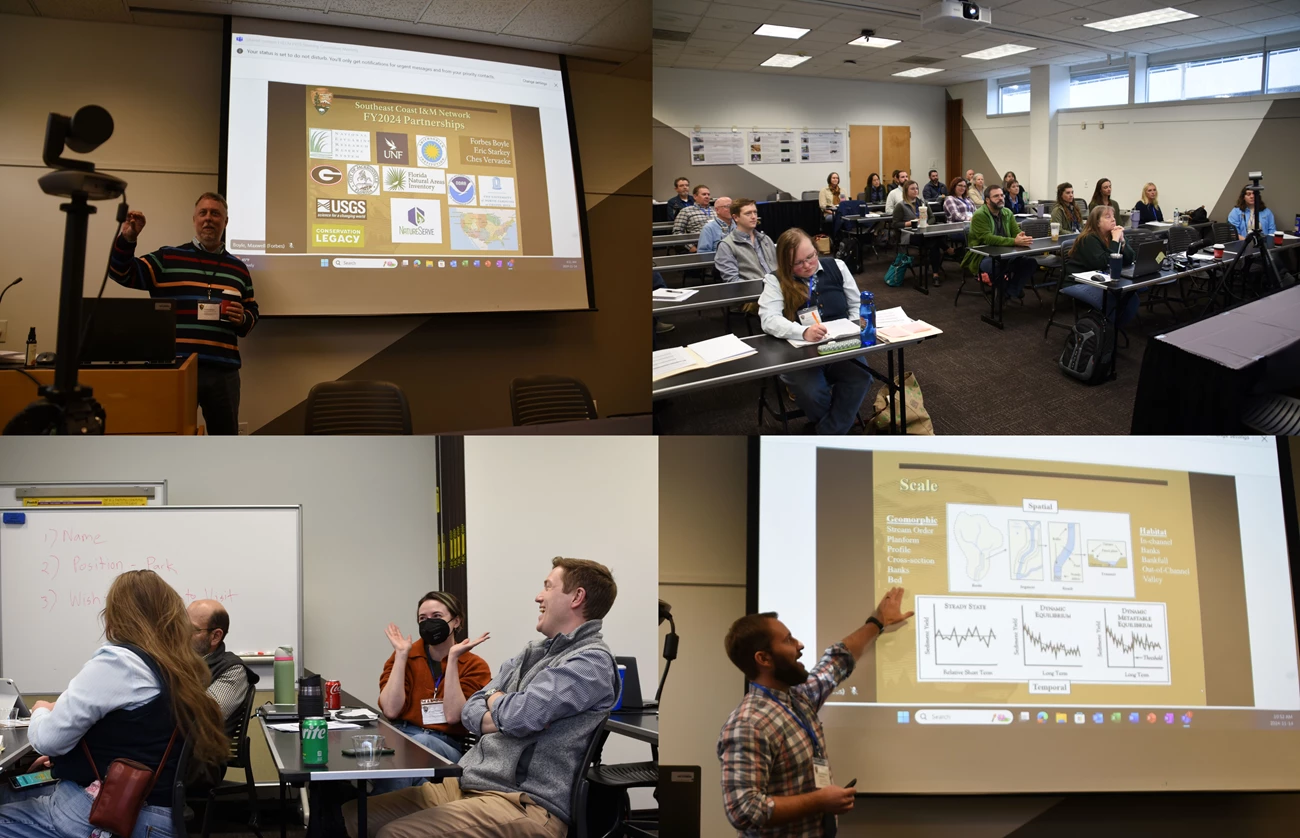
NPS photos / SECN staff
New for this year, SIP Intern Elena Kelly talked about her experience with the network and Lisa Nelson and Rebecca Port from the IMD office in Fort Collins provided an update on the revamped Natural Resource Inventories and Assessments Program.
Botanist and Acting Program Manager Forbes Boyle, Aquatic Ecologist Eric Starkey and Coastal Ecologist Ches Vervaeke went in depth into the various partnerships that help the network with its monitoring efforts. There was also a demonstration of the new SER Invasive Species AGOL Tool by IMD Geospatial Specialist Mina Nada. In addition, Lauren Serra gave an update on the Southeast Coast Invasive Plant Management Team, and Regional Program Manager Brian Gregory and Associate Regional Director of Resource, Stewardship and Science, Darrell Echols, gave updates from the regional and national IMD perspective.
Monitoring protocol leads presented highlights from 2024 and workplans for 2025. The meeting was capped by an intense round of SECN Trivia which was won by Krista Pollett, the Acting Integrated Resource Chief at Fort Sumter and Fort Moultrie National Historical Park-Charles Pinckney National Historic Site. Special thanks to Biological Technician Mallorie Davis for putting that together. Thanks to everyone who was able to attend and provide feedback on our program. Copies of the approved Work Plan will be sent to the SECN Steering Committee representatives, meeting attendees, and Park Superintendents. Let us know if you have any questions.
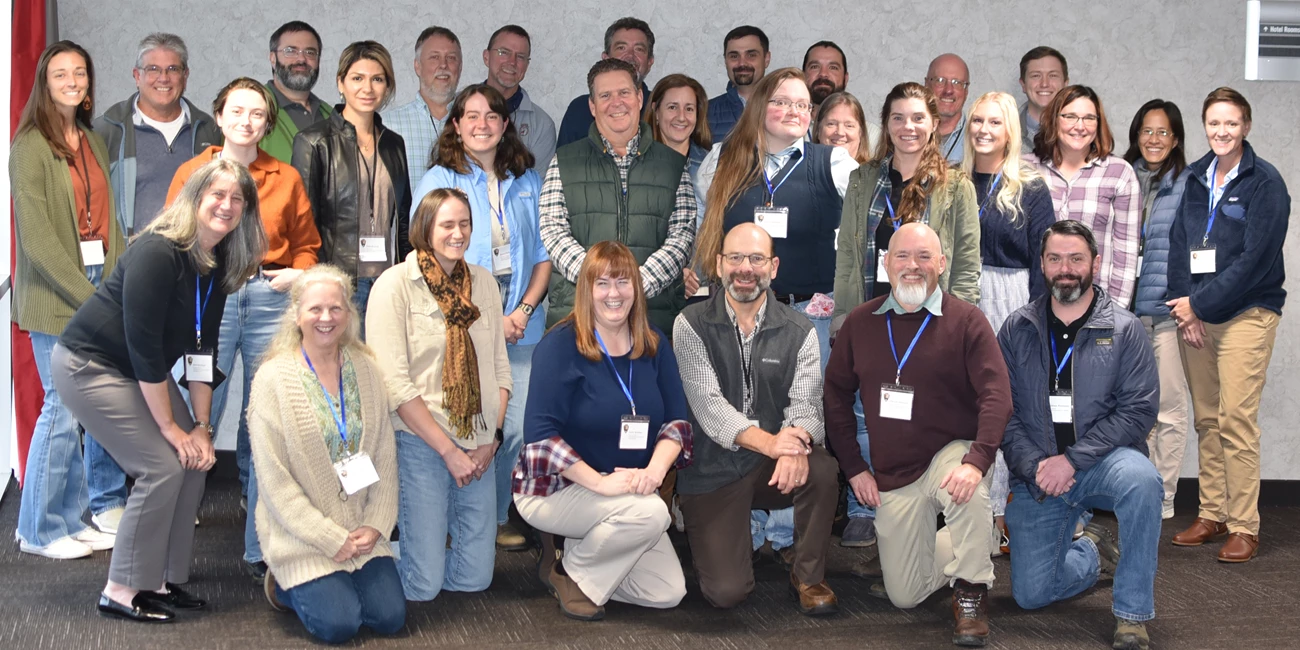
NPS photo / UGA staff
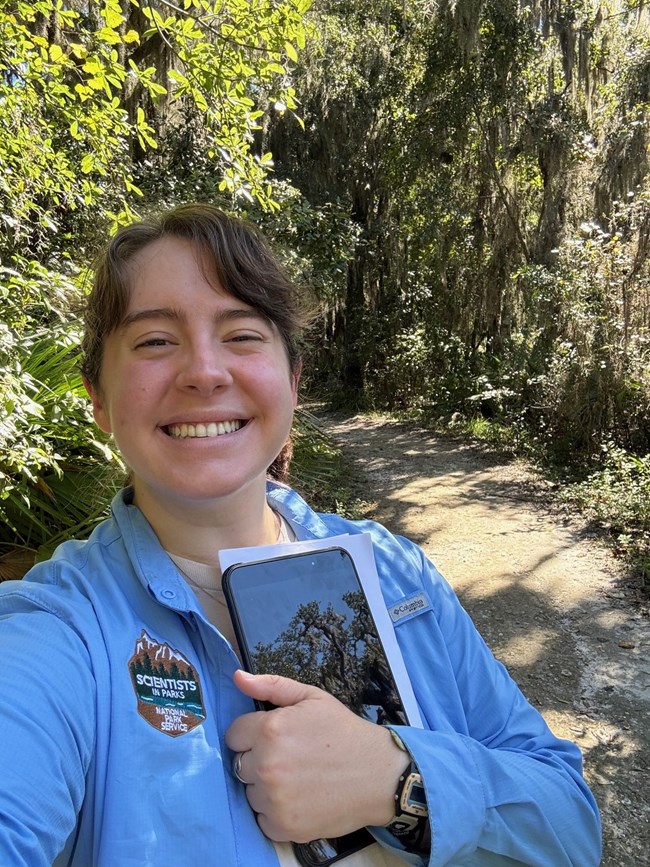
NPS photo / Elena Kelly
Goodbye Elena
Former SIP Intern Supported SECN and TIMU
Elena Kelly finished her 26-week Scientists in Parks (SIP) internship with the Southeast Coast Network and Timucuan Ecological and Historic Preserve in November. During the first three months of her internship, Elena’s primary task was to assist with terrestrial vegetation health monitoring with the SECN vegetation team at Cumberland Island National Seashore, Fort Frederica National Monument, and Chattahoochee River National Recreation Area. The survey plots, modeled after Carolina Vegetation Survey protocol, collected a plethora of data on seedling/sapling abundance, tree size and health, fuel load, canopy cover, and much more.
While stationed at Timucuan Ecological and Historic Preserve, Elena took on projects such as drafting Mayfly water quality student curriculum, analyzing weekly phytoplankton samples for the NOAA Phytoplankton Monitoring Network, monitoring a bald eagle nest with Audubon EagleWatch, mapping invasive plants, and co-leading volunteers and park staff in the Dragonfly Mercury Project. Elena also participated in outreach events such as the Guana Tolomato Matanzas National Estuarine Research Reserve's annual Estuary Fest and she developed her own interpretation pop-up exhibit at Fort Caroline National Memorial.
Elena said she is sad to leave, but grateful for all the skills and connections she is taking away from this SIP internship. The experience she gained in resource management will be particularly vital in the next steps of her career. She will pursue an M.S. in Forest Ecology at Clemson University starting in August 2025. Her project will examine six decades worth of management and ecology data from the Clemson Experimental Forest and the Hardscrabble property. Elena plans to return to the National Park Service as a biotechnician after achieving her degree.
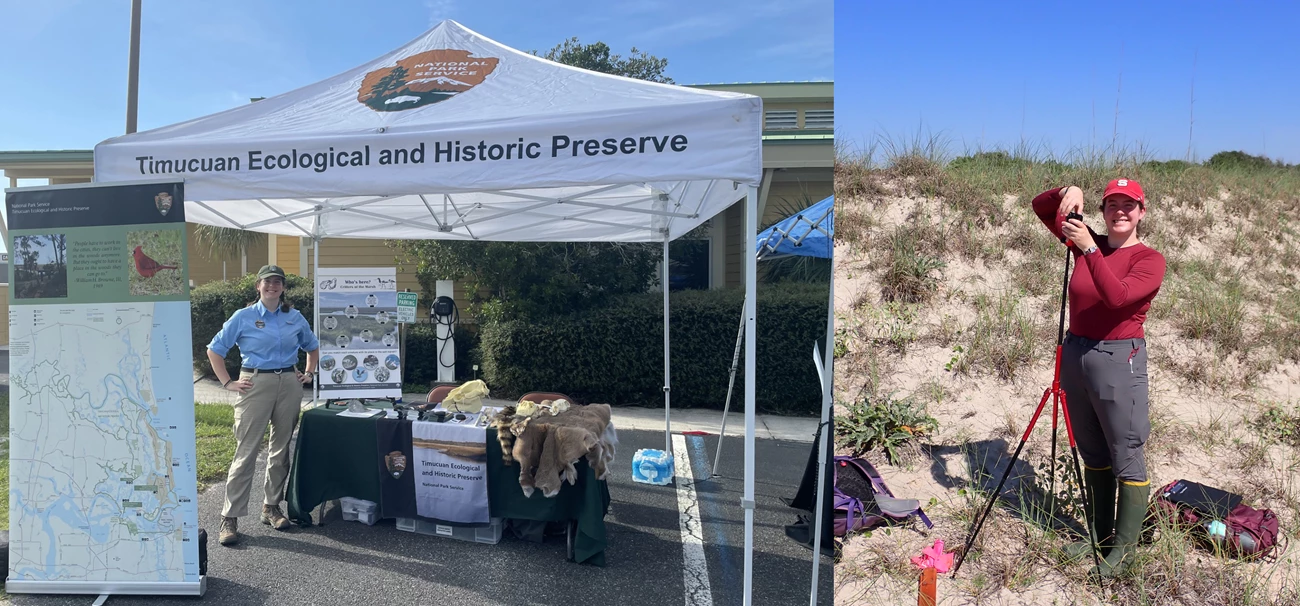
NPS photos / Elena Kelly
Goodbye to Wayne Too
Former Wildlife Intern Wraps Up at UGA
Wayne Ryan recently completed his time with the Southeast Coast Network as a Cooperative Ecosystem Studies Unit (CESU) Intern from the University of Georgia. He assisted with wildlife vocalization classification, field season preparations, ARD deployment and retrieval and data entry. Wayne worked in the Spatial Ecology Laboratory at UGA and conducted field research at the USDA Forest Service Coweeta Hydrologic Laboratory in western North Carolina involving bird banding, mist-netting, and point count surveys. This was in pursuit of a Masters in Science from the Warnell School of Forestry and Natural Resources with a concentration in Geospatial Information Science. Wayne, who earned his Bachelor of Science in Biology at Western Carolina University, will obtain his MS from UGA in January.
"I've learned plenty of new skills and a newfound appreciation for nature," said Wayne. "I've learned way more about autonomous recording units than I ever thought I would, including programming them, setting them up, and taking them down. This has also allowed me to travel to new NPS sites where I got to learn more about historic sites such as Horseshoe Bend National Military Park and Timucuan Ecological and Historical Preserve. It has been great getting to know everyone at SECN and even getting to occasionally join them for their fieldwork has been a blast too."
Wayne said he would like to continue working with wildlife and hiking outdoors. He hopes to work as a wildlife biologist for the National Park Service or a state agency.
"Working with birds would be a bonus," said Wayne. "Hopefully wherever I end up, I will be able to support the environment and nature around me."
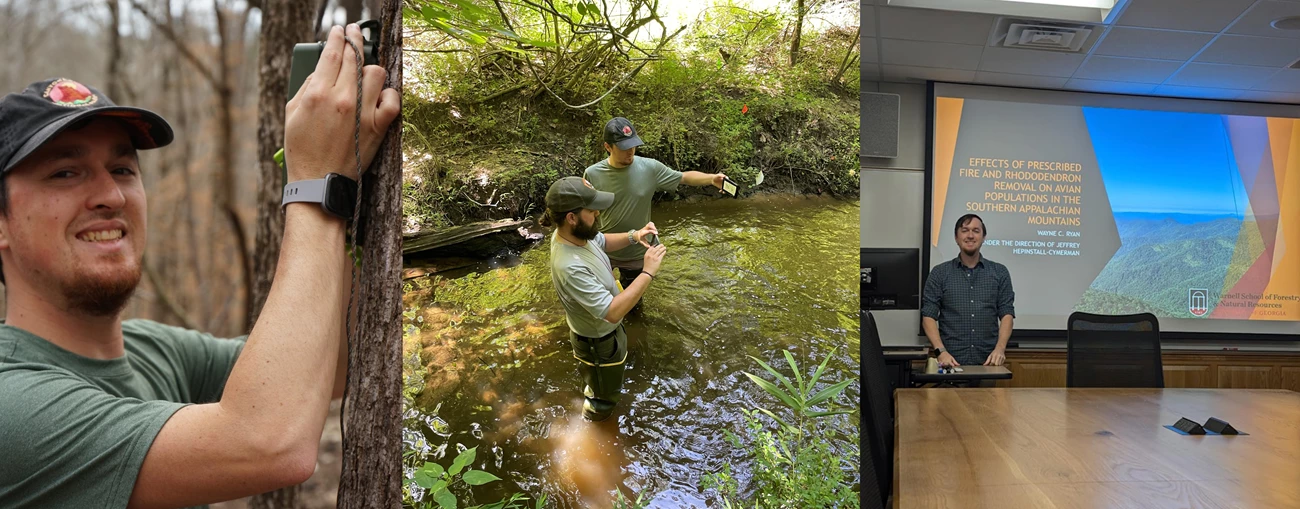
NPS photos / SECN staff
From the Data Manager
Wadeable Stream Data for Entire Period is Published
An updated Data Package has been published for the Wadeable Streams Habitat monitoring protocol. The data package is the first published by the network that contains the entire period of record for a single protocol, and is a milestone for the wadeable stream protocol and data management teams. The data package contains all wadeable stream habitat data from 2017 through the end of 2024.
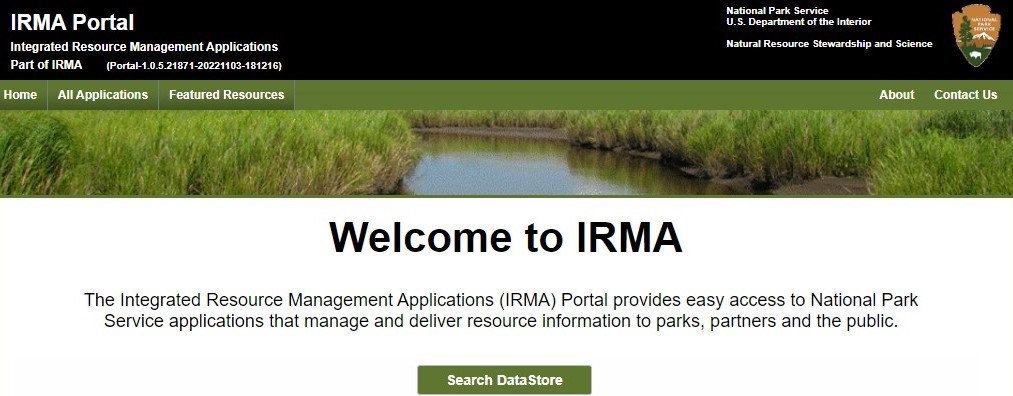
Recent Publications
The Southeast Coast Network recently published the following reports:
Terrestrial
- Terrestrial Vegetation Monitoring at Moores Creek National Battlefield: 2022 Data Summary. Available at: DataStore - Terrestrial vegetation monitoring at Moores Creek National Battlefield: 2022 data summary
- Terrestrial Vegetation Monitoring at Moores Creek National Battlefield: 2022 Data Summary Resource Brief. Available at: DataStore - Southeast Coast Network Vegetation Monitoring Resource Briefs
Landbirds and Anurans
- Landbird Monitoring in Southeast Coast Network Parks: 2022 Data Summary for Fort Frederica National Monument. Available at: DataStore - Landbird Monitoring in Southeast Coast Network parks: 2022 Data Summary for Fort Frederica National Monument. 2022 Species Maps for Fort Frederica National Monument. Available at: DataStore - Landbird Monitoring in Southeast Coast Network parks: 2022 Species Maps for Fort Frederica National Monument
- Landbird Monitoring in Southeast Coast Network Parks: 2022 Data Summary for Canaveral National Seashore. Available at: DataStore - Landbird Monitoring in Southeast Coast Network parks: 2022 Data Summary for Canaveral National Seashore. 2022 Species Maps for Canaveral National Seashore. Available at: DataStore - Landbird Monitoring in Southeast Coast Network parks: 2022 Species Maps for Canaveral National Seashore
- Landbird Monitoring in Southeast Coast Network Parks: 2022 Data Summary for Moores Creek National Battlefield. Available at: DataStore - Landbird Monitoring in Southeast Coast Network parks: 2022 Data Summary for Moores Creek National Battlefield. 2022 Species Maps for Moores Creek National Battlefield. Available at: DataStore - Landbird Monitoring in Southeast Coast Network parks: 2022 Species Maps for Moores Creek National Battlefield
- Landbird Monitoring in Southeast Coast Network Parks: 2022 Data Summary for Ocmulgee Mounds National Historical Park. Available at: DataStore - Landbird Monitoring in Southeast Coast Network parks: 2022 Data Summary for Ocmulgee Mounds National Historical Park. 2022 Species Maps for Ocmulgee Mounds National Historical Park. Available at: DataStore - Landbird Monitoring in Southeast Coast Network parks: 2022 Species Maps for Ocmulgee Mounds National Historical Park
- Landbird Monitoring in Southeast Coast Network parks: 2016 Data Summaries for Cape Lookout National Seashore and Fort Sumter and Fort Moultrie National Historical Park. Available at: DataStore - Landbird Monitoring in Southeast Coast Network parks: 2016 Data Summaries. Landbird Monitoring in Southeast Coast Network Parks: Printed Species Maps 2016. Available at: DataStore - Landbird Monitoring in Southeast Coast Network Parks: Printed Species Maps 2016
- Vocal Anuran Monitoring in Southeast Coast Network parks: 2015 Data Summaries for Cape Hatteras National Seashore, Chattahoochee River National Recreation Area, Fort Matanzas National Monument, Fort Pulaski National Monument and Timucuan Ecological and Historic Preserve. Available at: DataStore - Vocal Anuran Monitoring in Southeast Coast Network parks: 2015 Data Summaries. Vocal Anuran Monitoring in Southeast Coast Network Parks: Printed Species Maps 2015. Available at: DataStore - Vocal Anuran Monitoring in Southeast Coast Network Parks: Printed Species Maps 2015
- Vocal Anuran Monitoring in Southeast Coast Network parks: 2016 Data Summaries for Cape Lookout National Seashore, Cumberland Island National Seashore, Fort Sumter and Fort Moultrie National Historical Park, Horseshoe Bend National Military Park and Kennesaw Mountain National Battlefield Park. Available at: DataStore - Vocal Anuran Monitoring in Southeast Coast Network parks: 2016 Data Summaries. Vocal Anuran Monitoring in Southeast Coast Network Parks: Printed Species Maps 2016. Available at: DataStore - Vocal Anuran Monitoring in Southeast Coast Network Parks: Printed Species Maps 2016
- Vocal Anuran Monitoring in Southeast Coast Network parks: 2022 Data Summary for Canaveral National Seashore. Available at: DataStore - Vocal Anuran Monitoring in Southeast Coast Network parks: 2022 Resource Brief for Canaveral National Seashore. Vocal Anuran Monitoring in Southeast Coast Network Parks: Printed Species Maps 2022 for Canaveral National Seashore. Available at: DataStore - Vocal Anuran Monitoring in Southeast Coast Network parks: 2022 Species Maps for Canaveral National Seashore
- Vocal Anuran Monitoring in Southeast Coast Network parks: 2022 Data Summary for Congaree National Park. Available at: DataStore - Vocal Anuran Monitoring in Southeast Coast Network parks: 2022 Resource Brief for Congaree National Park. Vocal Anuran Monitoring in Southeast Coast Network Parks: Printed Species Maps 2022 for Congaree National Park. Available at: DataStore - Vocal Anuran Monitoring in Southeast Coast Network parks: 2022 Species Maps for Congaree National Park
- Vocal Anuran Monitoring in Southeast Coast Network parks: 2022 Data Summary for Fort Frederica National Monument. Available at: DataStore - Vocal Anuran Monitoring in Southeast Coast Network parks: 2022 Resource Brief for Fort Frederica National Monument. Vocal Anuran Monitoring in Southeast Coast Network Parks: Printed Species Maps 2022 for Fort Frederica National Monument. Available at: DataStore - Vocal Anuran Monitoring in Southeast Coast Network parks: 2022 Species Maps for Fort Frederica National Monument
- Vocal Anuran Monitoring in Southeast Coast Network parks: 2022 Data Summary for Moores Creek National Battlefield. Available at: DataStore - Vocal Anuran Monitoring in Southeast Coast Network parks: 2022 Resource Brief for Moores Creek National Battlefield. Vocal Anuran Monitoring in Southeast Coast Network Parks: Printed Species Maps 2022 for Moores Creek National Battlefield. Available at: DataStore - Vocal Anuran Monitoring in Southeast Coast Network parks: 2022 Species Maps for Moores Creek National Battlefield
- Vocal Anuran Monitoring in Southeast Coast Network parks: 2022 Data Summary for Ocmulgee Mounds National Historical Park. Available at: DataStore - Landbird Monitoring in Southeast Coast Network parks: 2022 Data Summary for Ocmulgee Mounds National Historical Park. Vocal Anuran Monitoring in Southeast Coast Network Parks: Printed Species Maps 2022 for Ocmulgee Mounds National Historical Park. Available at: DataStore - Vocal Anuran Monitoring in Southeast Coast Network parks: 2022 Species Maps for Ocmulgee Mounds National Historical Park
- Vocal Anuran Monitoring in Southeast Coast Network parks: 2023 Data Summaries for Fort Pulaski National Monument. Available at: DataStore - Vocal Anuran Monitoring in Southeast Coast Network parks: 2023 Resource Brief for Fort Pulaski National Monument. Vocal Anuran Monitoring in Southeast Coast Network Parks: Printed Species Maps 2023. Available at: DataStore - Vocal Anuran Monitoring in Southeast Coast Network parks: 2023 Species Maps for Fort Pulaski National Monument
For More About the SECN
Check out Southeast Coast Inventory & Monitoring Network (U.S. National Park Service) (https://www.nps.gov/im/secn/index.htm)Tags
- canaveral national seashore
- cape lookout national seashore
- cape hatteras national seashore
- cumberland island national seashore
- timucuan ecological and historic preserve
- congaree national park
- chattahoochee river national recreation area
- moores creek national battlefield
- horseshoe bend national military park
- kennesaw mountain national battlefield park
- ocmulgee mounds national historical park
- fort matanzas national monument
- fort pulaski national monument
- fort sumter and fort moultrie national historic park
- terrestrial vegetation monitoring
- wadeable stream habitat monitoring
- estuarine water and sediment quality
- fixed station water quality
- landbird community monitoring
- vocal anuran community monitoring
- water-quality data monitoring
- secn network highlights
